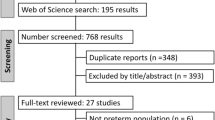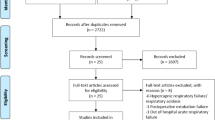Abstract
Objectives
To describe the frequency of non-invasive ventilation (NIV) and endotracheal intubation use in neonates diagnosed with respiratory distress syndrome (RDS); to describe resources utilization (length of stay (LOS), charges, costs) among NIV and intubated RDS groups.
Study design
Retrospective study from the national Kid’s Inpatient Database of the Healthcare Cost and Utilization Project, for the years 1997–2012. Propensity scoring and multivariate regression analysis used to describe differences.
Results
A total of 595,254 out of 42,912,090 cases were identified with RDS. There was an increase in NIV use from 6% in 1997 to 17% in 2012. After matching, patients receiving NIV only were associated with shorter LOS: (95%CI) 25 (25.3,25.7) vs. 35 (34.2,34.9) days, decreased costs: ($/1k) 46.1 (45.5,46.8) vs. 65.0 (64.1,66.0), decreased charges: 130.3 (128.6,132.1) vs. 192.1 (189.5,194.6) compared to intubated neonates.
Conclusion
There was a three-fold increase in NIV use within the 15-year study period. NIV use was associated with decreased LOS, charges and costs compared to intubated patients.
This is a preview of subscription content, access via your institution
Access options
Subscribe to this journal
Receive 12 print issues and online access
$259.00 per year
only $21.58 per issue
Buy this article
- Purchase on SpringerLink
- Instant access to full article PDF
Prices may be subject to local taxes which are calculated during checkout



Similar content being viewed by others
References
Centers for Disease Control and Prevention. National Center for Health Statistics. National Vital Statistics Report 2013.
March of Dimes. Peristats. Infant deaths by cause of death: United States 2013.
Dahlem P, Van Aalderen WM, Hamaker ME, Dijkfraaf MG, Bos AP. Incidence and short-term outcome of acute lung injury in mechanically ventilated children. Eur Respir J. 2003;22:980–5.
Papile LA, Polin RA, Carlo WA, Tan R, Kumar P, Benitz W, et al. Committee on Fetus and Newborn; American Academy of Pediatrics. Respiratory support in preterm infants at birth. Pediatrics. 2014;133:171–4.
Stevens TP, Harrington EW, Blennow M, Soll RF Early surfactant administration with brief ventilation vs. selective surfactant and continued mechanical ventilation for preterm infants with or at risk for respiratory distress syndrome. Cochrane Database of Syst Rev 2007;4:CD003063.
Sweet DG, Carnielli V, Greisen G, Hallman M, Ozek E, Plavka R, et al. European Consensus Guidelines on the Management of Neonatal Respiratory Distress Syndrome in Preterm Infants. Neonatology. 2010;97:402–17.
De Winter JP, de Vries MAG, Zimmermann LJI. Clinical practice: Noninvasive respiratory support in newborns. Eur J Pediatr. 2010;169:777–82. https://doi.org/10.1007/s00431-010-1159-x.
Salvo V, Lista G, Lupo E, Ricotti A, Zimmermann L, Gavilanes A, et al. Noninvasive Ventilation Strategies for Early Treatment of RDS in Preterm Infants: An RCT. Pediatrics. 2015;135:444–51. https://doi.org/10.1542/peds.2014-0895.
Hatch L, Grubb PH, Lea AS, Walsh WF, Markham MH, Whitney GM, et al. Endotracheal Intubation in Neonates: A Prospective Study of Adverse Safety Events in 162 Infants. J Pediatr. 2016;168:62–8.
Berger J, Mehta P, Bucholz E, Dziura J, Bhandari V. Impact of Early Extubation and Reintubation on the Incidence of Bronchopulmonary Dysplasia in Neonates. Am J Perinatol. 2014;31:1063–72.
Isayama T, Chai-Adisaksopha C, McDonald SD. Noninvasive ventilation with vs without early surfactant to prevent chronic lung disease in preterm infants: a systematic review and metaanalysis. JAMA Pediatrics 2015;169:731–9. https://doi.org/10.1001/jamapediatrics.2015.0510.
Parsons LS. Performing a 1:N Case-Control Match on Propensity Score. Proceedings of the Twenty-Ninth Annual SAS Users Group International Conference, Cary, NC: SAS Institute Inc., 2001.
Lumley T, Diehr P, Emerson S, Chen L. The importance of the normality assumption in large public health data sets. Annu Rev Public Health. 2002;23:151–9.
Bhandari V. Non-Invasive respiratory support in the preterm infant. Clin Perinatol. 2012;29:497–511.
Wilinska M, Bachman T, Swietlinski J, Gajewska E, Meller J, Helwich E, et al. Impact of the shift to neonatal invasive ventilation in Poland: a population study. Pediatr Crit Care Med. 2014;15:155–61.
Bhandari V. The potential of non-invasive ventilation of decrease BPD. Semin Perinatol. 2013;37:108–14.
Morley CJ, Davis PG, Doyle LW, Brion LP, Hascoet JM, Carlin JP, et al. Nasal CPAP or intubation at birth for very preterm infants. N Engl J Med. 2008;358:700–8.
Leveque BM, Kalish LA, LaPierre J, Welch M, Porter V. Impact of implementing 5 potentially better respiratory practices on neonatal outcomes and costs. Pediatrics. 2011;128:e218–26.
Kann IC, Solevag AL. Economic and health consequences of non-invasive respiratory support in newborn infants: a difference-in-difference analysis using data from the Norwegian patient registry. BMC Health Serv Res. 2014;14:494.
Funding
Dr. AL is supported by the National Center for Advancing Translational Science (NCATS) of the U.S. National Institutes of Health (KL2TR001854).
Author contributions
Mr. TAC and Dr. AL made substantial contributions to designing the study, analyzing the data, and interpreting the results, and wrote the first draft of the manuscript. Dr. AL made substantial contributions to designing the study, analyzing the data, and interpreting the results. Ms. LF wrote the first draft of the manuscript. Drs. NI, TAS, AG, PSF, and RR also assisted in interpreting the results and revising the manuscript. All authors reviewed and approved of the final version of the manuscript.
Author information
Authors and Affiliations
Corresponding author
Ethics declarations
Conflict of interest
The authors declare that they have no conflict of interest.
Electronic supplementary material
Rights and permissions
About this article
Cite this article
Chavez, T.A., Lakshmanan, A., Figueroa, L. et al. Resource utilization patterns using non-invasive ventilation in neonates with respiratory distress syndrome. J Perinatol 38, 850–856 (2018). https://doi.org/10.1038/s41372-018-0122-y
Received:
Revised:
Accepted:
Published:
Issue date:
DOI: https://doi.org/10.1038/s41372-018-0122-y
This article is cited by
-
Prediction of extubation failure among low birthweight neonates using machine learning
Journal of Perinatology (2023)



